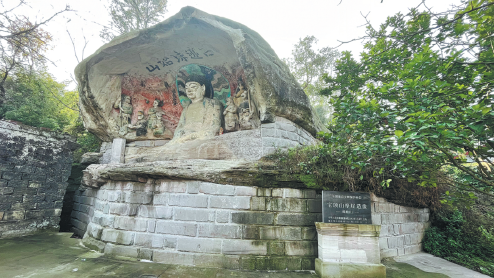

"They feature exquisite carvings, a diversity of themes and rich content, providing a true reflection of the political, economic and social history of the Sichuan and Chongqing regions during the Tang (618-907) and Song (960-1279) periods," says Jiang Siwei, head of the Academy of Dazu Rock Carvings.
However, due to a variety of factors, their overall state of preservation is relatively poor. The 68 small- and medium-sized cave temple sites are scattered across the countryside and streets of 18 towns around the district, which creates difficulties in their management.
As their significance was increasingly recognized, the academy worked on repairing protective structures at 13 of the 68 sites in the district and reinforced rock mass at three sites between 2001 and 2019.
However, many rock carvings remain exposed to the natural environment, causing issues such as rock fissures, loosening, water seepage, moss and lichen growth, the peeling of paint and weathering.
"These problems have accelerated the deterioration of the statues, posing a threat to their safety," Jiang says.
Multiple sites did not have sufficient power, and 50 locations did not have full surveillance facilities, which hampered safety monitoring of the statues, as well as archaeological research, among other conservation efforts, Jiang recalls.
In 2021, Dazu launched a new round of protection for scattered cave temples, encompassing the reinforcement of precarious expanses of rock, the construction of protective architecture, drainage, fire ponds, as well as security, sanitation and lighting protection facilities.
The project is spread over an area of 40,000 square meters and will be carried out in three phases, according to the academy.
The first phase has already been completed, with the condition of rock carvings at multiple small- and medium-sized cave temples improved.
At the Shuchengyan site in Zhongao, a cave temple has recently undergone preliminary restoration, thanks to the efforts of an Italian cultural heritage cluster and the Academy of Dazu Rock Carvings.
The project started in 2018, with a yearlong series of experiments and analysis conducted by both sides on gold leaf, paint, rock and microorganisms, as well as repair techniques, before restoration began.
"The temple was very popular in the past and attracted a lot of local worshippers," says Ruan Fanghong, an official who is part of the project.
As a result, many rock carvings became covered in soot and were damaged.
The two teams applied a synthetic enzyme to remove impurities from the paint, and then used polyvinyl alcohol to paste the peeling gold leaf back in place.
"Now, several years have passed, and the restored parts are holding up very well," Ruan says.